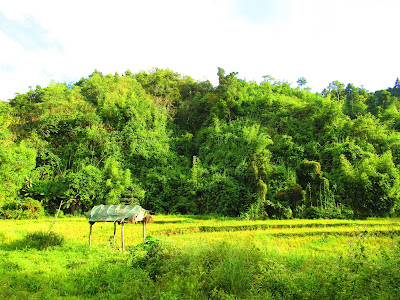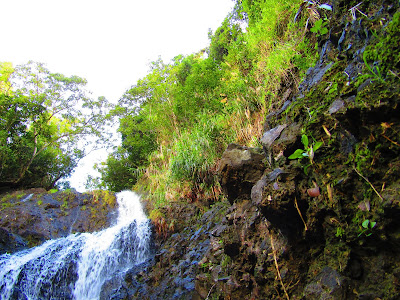The more than 800-hectare of the protected Fuyot Springs National Park in Ilagan, Isabela houses the lost, mystical waterfalls named Pinzal. On the average, it will need you to walk an hour or more to get the splash of the 20-meter cascading spring falls. Like Dora the Explorer's "Map", you need to pass several obstacles before reaching your destination. Somehow, your reward will be fantastic.
THE HANGING BRIDGE
A steel cable bridge hanging 10 meters above the huge trunk of trees, such as molave, mahogany, narra and ipil, this will lead you to the entrance of the Altar cave, so called because of its nearly perfect intricate designs ranging from a Holy Sto. Nino, an angel, a saint, and other religious shapes.
THE THICK FOREST
 |
| Sunlight hardly penetrate the forest floor due to the thickness of vegetation. Ferns, vines and epiphytes suffocate trees along the way. |
Traversing the forest, you will likely hear different chants of birds, monkeys howl, leaves whisper, and possibly a wild deer's bleat.
 |
| The canopy is home to birds of prey such as hawks, eagles and other raptors. |
 |
Don't forget to bring your amenities: water, flashlight, candies, compass, waterproof watch, among others.
THE CAVERN |
 |
Sta. Victoria cave system is known for its sparkling rocks, dripping stalactites and living limestone formations that change dramatically in a short time.
|
 |
| On the other end of the cave, a rocky forest road awaits your feet. Bring your hiking, waterproof shoes. |
THE MAINSTREAM
 |
If you're a novice hiker, a tour guide may help. They do not receive salary from LGU and they do their job voluntarily. Somehow, they may touch the generosity of your heart.
A kilometer of clear, alkaline spring water coming from the pinzal falls will bless your feet as you hike. There is no way not to get wet unless you back out. At some point, the water level will reach up to above the knees.
Mang Freddie Allauigan who accompanied me to the Pinzal falls was my tour guide. You can contact him at 09268766914. During the trek, we got hungry and we shared one piece of a bavarian Crossini at Pandolino. bring your rice if it does not bother you.
Live shrimp, forest crabs, bunog fish and edible snails, locally known as agurong and leddeg, fill up the stream undisturbed.
The native Dumagats and Agtas or the Aetas used to drink the alkaline spring water. It prevents cancer. Well, at some point, maybe because cancer cells thrive in an acidic environment.
My guide told me that this area was once a Japanese fortification. Many of them hid inside the cave to elude the Allies. If you are new to the area, you better hire a guide. Who knows you'll lose your way to enchantment?
Above a huge rock, I can clearly see how this squad enjoyed the cooling waters of Pinzal as we went through our way with my guide.
THE VAST CORNFIELD
As far as the eye can see, all you see is corn. No wonder why Isabela Province is the corn capital of the Philippines.
Behind that mountain as you pass through the cornfields, you'll reach your destination: The falls.
THE MOUNTAINS
These rolling hills will be your last obstacles along your way. Still far from Pinzal, at least the picturesque will give you some relief of serenity, peace of mind, away from the stressful city life.
A solitary waiting shed awaits visitors to stop over on its shade. If you reach this mark, you're now halfway to the grand rapids.
You may opt to use bamboo rods as your walking stick so as to avoid being slipped into the muds and huge rocks along the way.
Climbing this slope, like the north face, is at last! ...the source of life! The falls.
THE PINZAL FALLS
Finally, Dora the Explorer's map has been exhausted. The timid falls teach us a lesson. A lesson that tells us to be humble and be contented for what nature could give us. For the one who loves nature, he will find this beautiful. It was again proven that beauty is not elegance. It's appreciation.
|


























